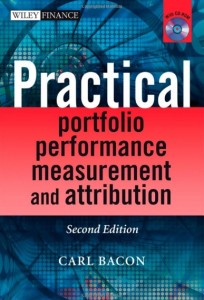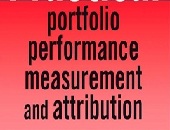“The guiding principles for risk control,” said Carl Bacon, CIPM, Chairman of Statpro, and former Director of Risk Control and Performance at F&C Investment Management Ltd, “are integration and confidence in data.” Bacon was in Toronto on September 17, 2012 to deliver a one-day workshop on risk-adjusted performance measurement to about a dozen members of the CFA Society Toronto as part of the Society’s continuing education program. He is the author of Practical Portfolio Performance Measurement & Attribution, which went into its second edition in 2008.
 Performance measurement is the calculation of portfolio return for purposes of comparison against a benchmark and peer group . Proper attribution of risk and return is necessary, Bacon noted, because portfolio managers “are selling their competency to manage assets. This is where [they] really begin to justify [their] salaries.” Risk analysis is crucial and must be an integrated part of performance measurement to determine whether we are “getting sufficient reward for the risk we are taking.” Feedback into the investment decision-making process will add significantly to the improvement thereof.
Performance measurement is the calculation of portfolio return for purposes of comparison against a benchmark and peer group . Proper attribution of risk and return is necessary, Bacon noted, because portfolio managers “are selling their competency to manage assets. This is where [they] really begin to justify [their] salaries.” Risk analysis is crucial and must be an integrated part of performance measurement to determine whether we are “getting sufficient reward for the risk we are taking.” Feedback into the investment decision-making process will add significantly to the improvement thereof.
Bacon emphasized that risk is not just about loss; it’s about the uncertainty of expected outcomes. “Risk is actually a good thing” because “it’s how you will get return.” He divided risk into five types: compliance risk, operational, counterparty, portfolio, and liquidity risk. This is a change from the credit-market-operational-strategic dissection of risk that is popular in many textbooks. His is a working definition for fund managers, borne of immersion in his role as Director of Risk Control for a London buy-side firm.
Bacon defined compliance risk as broader than regulatory risk. There are client-determined limits, regulatory limits, and internal limits. These are collected in the Investment Management Agreement (IMA), which lays out the duties, risk limits, performance fees, and exclusion of liability.
Operational risk is short-hand for “how good is your back office,” said Bacon. There must be efficient processes in place for settlement, good liquid valuations, and error monitoring. Internal audit systems must keep an eye on error tracking, even the errors that generate profits. When a portfolio manager trades, a counterparty is generated. Bacon emphasized it’s important to “monitor where your counterparties are, and to know what’s your biggest risk exposure.” Derivatives exposure and stock lending as part of short selling should be transparent, with aggregation of counterparty exposure being easy to determine on, say, a daily basis. Bacon said that when Barings Bank was having trouble, it took as long as two weeks for some managers to work out their correct exposure to Barings. The deals were that complex and the data systems were that antiquated.
 Bacon drew a distinction between risk managers, who work in the front office and are paid to take risk, versus risk controllers, who work in the middle office and are paid to monitor and/or reduce risk. A natural tension exists between the two.
Bacon drew a distinction between risk managers, who work in the front office and are paid to take risk, versus risk controllers, who work in the middle office and are paid to monitor and/or reduce risk. A natural tension exists between the two.
Bacon chose a real-life example about portfolio risk that was not as well-known here as in the UK (his home base). He used it to show that it’s not enough to manage within agreed limits; a portfolio must be managed to whatever specific client expectations are part of the IMA. He cited the case of Unilever’s suit against Merrill, circa 2001. Merrill had accepted the client’s expectation that no 12-month performance average would be less than 3 percent below benchmark. The next year the benchmark grew an astonishing 33 percent. The Merrill performance of only 20 percent growth looked positively anemic by comparison. Unilever did not sue for underperformance; it sued for negligence (claiming the risk controls were not properly applied and monitored in the context of their performance expectations). The moral of the story, concluded Bacon, is to “mind the expectations” (as specifically laid out in the IMA).
The workshop participants turned their attention to assessing the riskiness of the funds. The remainder of the day was devoted to the calculation and interpretation of risk measures. An overview is given in Part 2. ª
Carl Bacon’s book, Practical Portfolio Performance Measurement & Attribution, 2nd ed can be found at its publisher’s page at: http://ca.wiley.com/WileyCDA/WileyTitle/productCd-0470059281.html
Ed. Note: Two months after the workshop, Carl Bacon’s latest book Practical Risk-Adjusted Performance Measurement (2012) was released.

